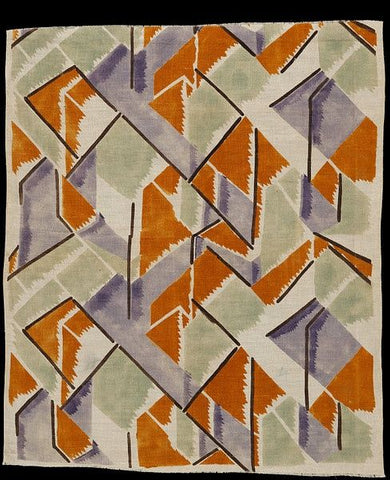Recently, I had the privilege of stepping into the historic Charleston House, once the cherished abode of Vanessa Bell and Duncan Grant part of the Bloomsbury Group. Nestled in the heart of East Sussex, this house is not just a testament to the artists' legacy, but also a living canvas of their creative prowess. Every corner, every wall, whispers tales of the illustrious Bloomsbury Group. I was particularly struck by the interiors - a symphony of colours, patterns, and emotions that seemed to defy the passage of time. I highly recommend a visit here as you won't be disappointed (https://www.charleston.org.uk/visit).

The Garden and Back House View Charleston House
It was this awe-inspiring visit that motivated me to delve deeper into one of the group's most fascinating ventures: The Omega Workshop looking at its furniture and fabrics. Since studying furniture design and restoration at the London College of Furniture in the mid-late 1980s - I have always been inspired by designers that have change the way we live in homes and The Omega Workshop, part of the modernist movement was ones one of these genres.

Ladies Head Bust Painted Sculpture Charleston House
In the early 20th century, amid the buzzing creativity and cultural transformations that characterised post-Victorian Britain, a particular artistic endeavour stands out: The Omega Workshops. Established in 1913 by Roger Fry, a member of the illustrious Bloomsbury Group, the Workshop emerged as a hub of avant-garde design. While the Bloomsbury Group is primarily celebrated for its contributions to literature, art, and philosophy, the Omega Workshop represents its foray into the world of design, particularly furniture and fabrics.

The Dining Room Charleston House
A Distinctive Aesthetic
At its core, the Omega Workshop was an embodiment of modernist principles. It aimed to blur the distinctions between fine art and applied art. Artists and designers, freed from the constraints of traditional craftsmanship, were encouraged to explore bold abstractions, vivid colors, and non-representational patterns. These designs were often unexpected and shocking to Edwardian sensibilities, making Omega pieces instantly recognisable.
For furniture, this translated to functional pieces that were also artistic statements. Rather than the intricately carved, wood-centric designs of the preceding era, Omega pieces featured stark geometries, a liberal use of paint, and a general departure from ornament for the sake of ornament. Tables, chairs, wardrobes – each bore the distinctive mark of the artist, replete with vibrant hues and dynamic forms.

Maud Fabric: Design by Vanessa Bell (The Omega Workshop)
Fabrics too underwent a revolution under the Omega umbrella. The floral motifs and subdued palettes that were popular in Victorian homes gave way to audacious patterns. Omega textiles embraced cubist, abstract, and even orientalist designs, leading to a rich tapestry of options for interior decorators and fashion designers alike. These fabrics, when used in conjunction with Omega furniture, allowed homeowners to transform their domestic spaces into modernist havens.
Beyond Commercial Endeavors
The Omega Workshop, however, was not solely about selling furniture and fabrics. It was an intellectual space, where ideas about art, design, and society were freely exchanged. Members of the Bloomsbury Group, including Virginia Woolf, Duncan Grant, and Vanessa Bell, frequently collaborated on designs or simply used the workshop as a space for inspiration.
Their collaborative ethos was evident in the way items were marked: rather than attributing designs to individual artists, pieces were simply marked with the Omega symbol. This lack of individual attribution was a radical move. It asserted that design, like other forms of art, could be a collaborative endeavour and not just the domain of solitary genius.

The Omega Workshop Red Painted Chairs 1913
Legacy and Influence
Despite its radical vision and the undeniable talent behind its creations, the Omega Workshop was short-lived, closing its doors in 1919. A combination of economic challenges, wartime disruptions, and the evolving tastes of the British public contributed to its demise. Yet, its influence endures. The Omega Workshop played a pivotal role in challenging established norms of art and design. It helped to pave the way for the broader acceptance of modernist principles in British design circles.
Today, the legacy of the Omega Workshop can be seen in the way we continue to value interdisciplinary collaborations between artists and designers. The spirit of experimentation and boundary-pushing that characterised Omega designs is alive and well in many contemporary design studios. While the Bloomsbury Group's literary and artistic contributions are often celebrated, the Omega Workshop serves as a powerful reminder of their broader cultural impact. In the realms of furniture and fabric design, they redefined the possible, championing a vision of modernism that continues to inspire today.

The Omega Workshop Painted Side Table 1913
As our little business GRUFFERTYS evolves we will be taking many of the principles formed by the Omega Workshop in collaborating with fellow craftspeople to create more artisan furniture and home décor pieces which are sustainable and stand the test of time. Watch this space next year for some exciting things to come from us and our talented team of experts.

About GRUFFERTYS: We wanted to make our online store a haven for all things vintage, antique and second-hand in the world of interiors. Whether you need help to style and mix old with new to make a home uniquely yours, or simply want to find an interesting piece to add personality, we’re here to help. We believe that everyone has the potential to create a beautiful home, regardless of budget – we also feel that this should be sustainable and here to help you create that perfectly imperfect home and safeguard the planet! Feel free to browse our collection www.gruffertys.com










